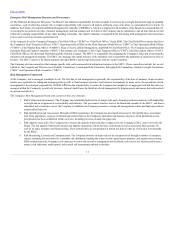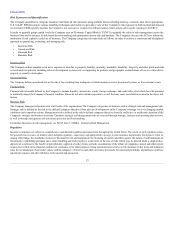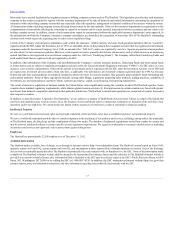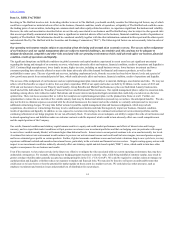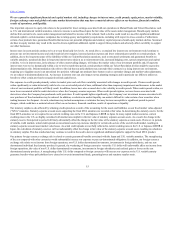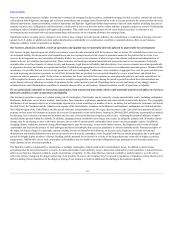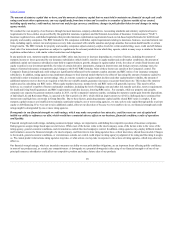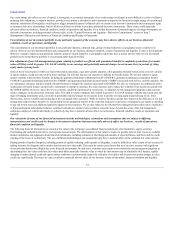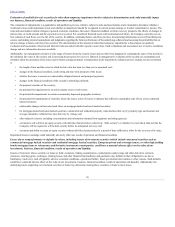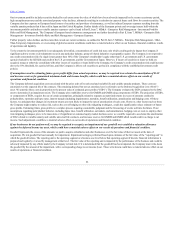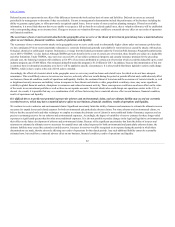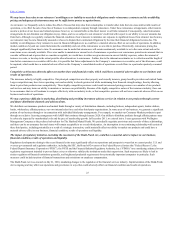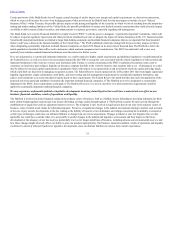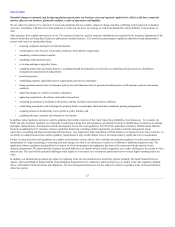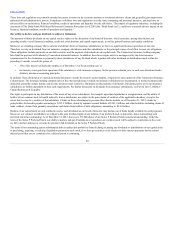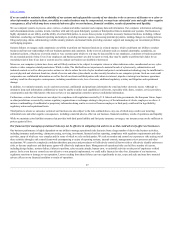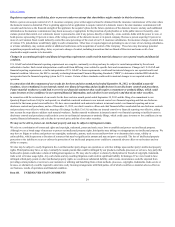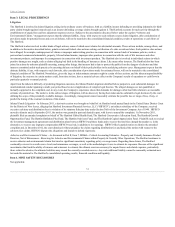The Hartford 2012 Annual Report Download - page 21
Download and view the complete annual report
Please find page 21 of the 2012 The Hartford annual report below. You can navigate through the pages in the report by either clicking on the pages listed below, or by using the keyword search tool below to find specific information within the annual report.
Table of Contents
Our investment portfolio includes securities backed by real estate assets the value of which have been adversely impacted by the recent recessionary period,
high unemployment rates and the associated property value declines, ultimately resulting in a reduction in expected future cash flows for certain securities. The
Company also has exposure to European based issuers of securities and providers of reinsurance, as well as indirect European exposure resulting from the
variable annuity products that it has sold in Japan and the United Kingdom. Further details of the European private and sovereign issuers held within the
investment portfolio and indirect variable annuity exposures can be found in Part II, Item 7, MD&A - Enterprise Risk Management - Investment Portfolio
Risks and Risk Management. The Company's European based reinsurance arrangements are further described in Part II, Item 7, MD&A - Enterprise Risk
Management - Investment Portfolio Risks and Risk Management - European Exposure.
Further property value declines and loss rates that exceed our current estimates, as outlined in Part II, Item 7, MD&A - Enterprise Risk Management - Other-
Than-Temporary Impairments, or a worsening of global economic conditions could have a material adverse effect on our business, financial condition, results
of operations and liquidity.
To the extent the investment portfolio is not adequately diversified, concentrations of credit risk may exist which could negatively impact the Company if
significant adverse events or developments occur in any particular industry, group of related industries or geographic regions. The Company is not exposed to
any credit concentration risk of a single issuer greater than 10% of the Company's stockholders' equity other than U.S. government and U.S. government
agencies backed by the full faith and credit of the U.S. government, and the Government of Japan. However, if issuers of securities or loans we hold are
acquired, merge or otherwise consolidate with other issuers of securities or loans held by the Company, the Company's credit concentration risk could increase
above the 10% threshold, for a period of time, until the Company is able to sell securities to get back in compliance with the established investment credit
policies.
If assumptions used in estimating future gross profits differ from actual experience, we may be required to accelerate the amortization of DAC
and increase reserves for guaranteed minimum death and income benefits, which could have a material adverse effect on our results of
operations and financial condition.
The Company deferred acquisition costs associated with the prior sales of its universal and variable life and variable annuity products. These costs are
amortized over the expected life of the contracts. The remaining deferred but not yet amortized cost is referred to as the Deferred Acquisition Cost (“DAC”)
asset. We amortize these costs in proportion to the present value of estimated gross profits (“EGPs”). The Company evaluates the EGPs compared to the DAC
asset to determine if an impairment exists. The Company also establishes reserves for GMDB and GMIB using components of EGPs. The projection of EGPs,
or components of EGPs, requires the use of certain assumptions, principally related to separate account fund returns in excess of amounts credited to
policyholders, surrender and lapse rates, interest margin (including impairments), mortality, benefit utilization, annuitization and hedging costs. Of these
factors, we anticipate that changes in investment returns are most likely to impact the rate of amortization of such costs. However, other factors such as those
the Company might employ to reduce risk, such as the cost of hedging or other risk mitigating techniques, could also significantly reduce estimates of future
gross profits. Estimating future gross profits is a complex process requiring considerable judgment and the forecasting of events well into the future. If our
assumptions regarding policyholder behavior, including lapse rates, benefit utilization, surrenders, and annuitization, hedging costs or costs to employ other
risk mitigating techniques prove to be inaccurate or if significant or sustained equity market declines occur, we could be required to accelerate the amortization
of DAC related to variable annuity and variable universal life contracts, and increase reserves for GMDB and GMIB which would result in a charge to net
income. Such adjustments could have a material adverse effect on our results of operations and financial condition.
If our businesses do not perform well, we may be required to recognize an impairment of our goodwill or to establish a valuation allowance
against the deferred income tax asset, which could have a material adverse effect on our results of operations and financial condition.
Goodwill represents the excess of the amounts we paid to acquire subsidiaries and other businesses over the fair value of their net assets at the date of
acquisition. We test goodwill at least annually for impairment. Impairment testing is performed based upon estimates of the fair value of the “reporting unit” to
which the goodwill relates. The reporting unit is the operating segment or a business one level below that operating segment if discrete financial information is
prepared and regularly reviewed by management at that level. The fair value of the reporting unit is impacted by the performance of the business and could be
adversely impacted by any efforts made by the Company to limit risk. If it is determined that the goodwill has been impaired, the Company must write down
the goodwill by the amount of the impairment, with a corresponding charge to net income (loss). These write downs could have a material adverse effect on our
results of operations or financial condition.
21


